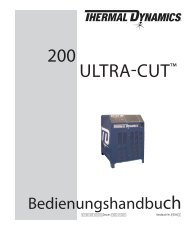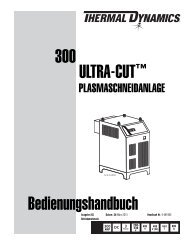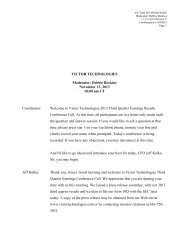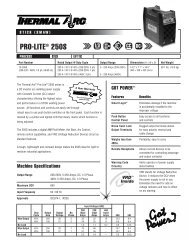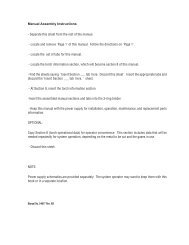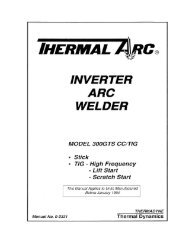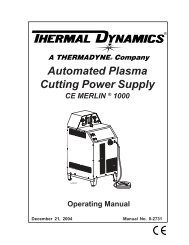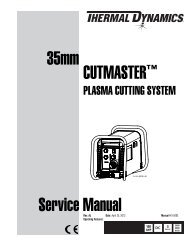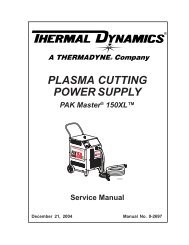cigweld alloycraft manual metal arc welding electrodes - Victor ...
cigweld alloycraft manual metal arc welding electrodes - Victor ...
cigweld alloycraft manual metal arc welding electrodes - Victor ...
Create successful ePaper yourself
Turn your PDF publications into a flip-book with our unique Google optimized e-Paper software.
CIGWELD ALLOYCRAFT MANUAL METAL ARC WELDING ELECTRODES<br />
Chemwatch Material Safety Data Sheet<br />
Issue Date: 8-Dec-2006 CHEMWATCH 17904<br />
NC317ECP Revision No:4<br />
CD 2006/3 Page 1 of 15<br />
Section 1 - CHEMICAL PRODUCT AND COMPANY IDENTIFICATION<br />
PRODUCT NAME<br />
CIGWELD ALLOYCRAFT MANUAL METAL ARC WELDING ELECTRODES<br />
SYNONYMS<br />
"Product Code: 614342-614344, 611922-611924", "611833-611835, 611963-611964, 611873<br />
-611875", 611893-611894, "Alloycraft range of Hydrogen Controlled Manual Metal Arc<br />
Welding Electrodes", "Alloycraft 70-A1, 80-B2, 80-C1, 90, 90-B3, 110"<br />
PRODUCT USE<br />
Flux coated hydrogen controlled <strong>electrodes</strong> for <strong>manual</strong> <strong>metal</strong> <strong>arc</strong> <strong>welding</strong>.<br />
SUPPLIER<br />
Company: CIGWELD Pty Ltd<br />
Address:<br />
71 Gower Street<br />
Preston<br />
VIC 3072<br />
AUS<br />
Telephone: (03) 9474 7400<br />
Telephone: 1300 654 674<br />
Emergency Tel: (03) 9474 7400<br />
Section 2 - HAZARDS IDENTIFICATION<br />
STATEMENT OF HAZARDOUS NATURE<br />
HAZARDOUS SUBSTANCE. NON-DANGEROUS GOODS. According to the Criteria of<br />
NOHSC, and the ADG Code.<br />
POISONS SCHEDULE<br />
None<br />
RISK SAFETY<br />
Limited evidence of a c<strong>arc</strong>inogenic effect. Wear suitable protective clothing.<br />
Use only in well ventilated areas.<br />
Keep container in a well ventilated place.<br />
To clean the floor and all objects contaminated<br />
by this material, use water and detergent.<br />
Keep away from food, drink and animal feeding<br />
stuffs.<br />
Take off immediately all contaminated clothing.<br />
If swallowed, IMMEDIATELY contact Doctor or<br />
Poisons Information Centre (show this container<br />
or label).<br />
Section 3 - COMPOSITION / INFORMATION ON INGREDIENTS<br />
NAME CAS RN %<br />
flux- coated mild steel wire which in use generates<br />
<strong>welding</strong> fumes Not avail. >60<br />
including<br />
continued...
CIGWELD ALLOYCRAFT MANUAL METAL ARC WELDING ELECTRODES<br />
Chemwatch Material Safety Data Sheet<br />
Issue Date: 8-Dec-2006 CHEMWATCH 17904<br />
NC317ECP Revision No:4<br />
CD 2006/3 Page 2 of 15<br />
Section 3 - COMPOSITION / INFORMATION ON INGREDIENTS<br />
iron oxide fume 1309-37-1<br />
fluoride fume 16984-48-8<br />
manganese fume 7439-96-5<br />
silica <strong>welding</strong> fumes 69012-64-2<br />
chromium fume 7440-47-3<br />
nickel fume 7440-02-0<br />
molybdenum fume 7439-98-7<br />
action of <strong>arc</strong> on air may generate<br />
ozone 10028-15-6<br />
nitrogen oxides Mixture<br />
Section 4 - FIRST AID MEASURES<br />
SWALLOWED<br />
Not normally a hazard due to the physical form of product. The material is a physical<br />
irritant to the gastro-intestinal tract.<br />
EYE<br />
SKIN<br />
INHALED<br />
- Particulate bodies from <strong>welding</strong> spatter may be removed carefully.<br />
- DO NOT attempt to remove particles attached to or embedded in eye.<br />
- Lay victim down, on stretcher if available and pad BOTH eyes, make sure dressing does<br />
not press on the injured eye by placing thick pads under dressing, above and below the<br />
eye.<br />
- Seek urgent medical assistance, or transport to hospital.<br />
- For "<strong>arc</strong> eye", i.e. <strong>welding</strong> flash or UV light burns to the eye:<br />
- Place eye pads or light clean dressings over both eyes.<br />
- Seek medical assistance.<br />
If skin or hair contact occurs:<br />
- Flush skin and hair with running water (and soap if available).<br />
- Seek medical attention in event of irritation.<br />
- If fumes or combustion products are inhaled remove from contaminated area.<br />
- Lay patient down. Keep warm and rested.<br />
- Prostheses such as false teeth, which may block airway, should be removed, where<br />
possible, prior to initiating first aid procedures.<br />
- Apply artificial respiration if not breathing, preferably with a demand valve<br />
resuscitator, bag-valve mask device, or pocket mask as trained. Perform CPR if necessary.<br />
- Transport to hospital, or doctor.<br />
NOTES TO PHYSICIAN<br />
Copper, magnesium, aluminium, antimony, iron, manganese, nickel, zinc (and their<br />
compounds) in <strong>welding</strong>, brazing, galvanising or smelting operations all give rise to<br />
thermally produced particulates of smaller dimension than may be produced if the <strong>metal</strong>s<br />
are divided mechanically. Where insufficient ventilation or respiratory protection is<br />
available these particulates may produce "<strong>metal</strong> fume fever" in workers from an acute or<br />
long term exposure.<br />
- Onset occurs in 4-6 hours generally on the evening following exposure. Tolerance<br />
develops in workers but may be lost over the weekend. (Monday Morning Fever)<br />
- Pulmonary function tests may indicate reduced lung volumes, small airway obstruction<br />
and decreased carbon monoxide diffusing capacity but these abnormalities resolve after<br />
several months.<br />
- Although mildly elevated urinary levels of heavy <strong>metal</strong> may occur they do not correlate<br />
with clinical effects.<br />
- The general approach to treatment is recognition of the disease, supportive care and<br />
continued...
CIGWELD ALLOYCRAFT MANUAL METAL ARC WELDING ELECTRODES<br />
Chemwatch Material Safety Data Sheet<br />
Issue Date: 8-Dec-2006 CHEMWATCH 17904<br />
NC317ECP Revision No:4<br />
CD 2006/3 Page 3 of 15<br />
Section 4 - FIRST AID MEASURES<br />
prevention of exposure.<br />
- Seriously symptomatic patients should receive chest x-rays, have arterial blood gases<br />
determined and be observed for the development of tracheobronchitis and pulmonary edema.<br />
[Ellenhorn and B<strong>arc</strong>eloux: Medical Toxicology].<br />
For acute or short term repeated exposures to fluorides:<br />
- Fluoride absorption from gastro-intestinal tract may be retarded by calcium salts, milk<br />
or antacids.<br />
- Fluoride particulates or fume may be absorbed through the respiratory tract with 20-30%<br />
deposited at alveolar level.<br />
- Peak serum levels are reached 30 mins. post-exposure; 50% appears in the urine within<br />
24 hours.<br />
- For acute poisoning (endotracheal intubation if inadequate tidal volume), monitor<br />
breathing and evaluate/monitor blood pressure and pulse frequently since shock may<br />
supervene with little warning. Monitor ECG immediately; watch for arrhythmias and<br />
evidence of Q-T prolongation or T-wave changes. Maintain monitor. Treat shock vigorously<br />
with isotonic saline (in 5% glucose) to restore blood volume and enhance renal excretion.<br />
- Where evidence of hypocalcaemic or normocalcaemic tetany exists, calcium gluconate (10<br />
ml of a 10% solution) is injected to avoid tachycardia.<br />
BIOLOGICAL EXPOSURE INDEX - BEI<br />
These represent the determinants observed in specimens collected from a healthy worker<br />
exposed at the Exposure Standard (ES or TLV):<br />
Determinant Index Sampling Time Comments<br />
Fluorides in urine 3 mg/gm creatinine Prior to shift B, NS<br />
10mg/gm creatinine End of shift B, NS<br />
B: Background levels occur in specimens collected from subjects NOT exposed<br />
NS: Non-specific determinant; also observed after exposure to other exposures.<br />
Section 5 - FIRE FIGHTING MEASURES<br />
EXTINGUISHING MEDIA<br />
- There is no restriction on the type of extinguisher which may be used.<br />
FIRE FIGHTING<br />
- Alert Fire Brigade and tell them location and nature of hazard.<br />
- Wear breathing apparatus plus protective gloves for fire only.<br />
- Prevent, by any means available, spillage from entering drains or water courses.<br />
- Use fire fighting procedures suitable for surrounding area.<br />
- DO NOT approach containers suspected to be hot.<br />
- Cool fire exposed containers with water spray from a protected location.<br />
- If safe to do so, remove containers from path of fire.<br />
- Equipment should be thoroughly decontaminated after use.<br />
FIRE/EXPLOSION HAZARD<br />
- Non combustible.<br />
- Not considered to be a significant fire risk, however containers may burn.<br />
- In a fire may decompose on heating and produce toxic / corrosive fumes.<br />
FIRE INCOMPATIBILITY<br />
Welding <strong>electrodes</strong> should not be allowed to come into contact with strong acids or other<br />
substances which are corrosive to <strong>metal</strong>s.<br />
Welding <strong>arc</strong> and <strong>metal</strong> sparks can ignite combustibles.<br />
continued...
CIGWELD ALLOYCRAFT MANUAL METAL ARC WELDING ELECTRODES<br />
Chemwatch Material Safety Data Sheet<br />
Issue Date: 8-Dec-2006 CHEMWATCH 17904<br />
NC317ECP Revision No:4<br />
CD 2006/3 Page 4 of 15<br />
Section 5 - FIRE FIGHTING MEASURES<br />
HAZCHEM: None<br />
Personal Protective Equipment<br />
Breathing apparatus.<br />
Gas tight chemical resistant suit.<br />
Limit exposure duration to 1 BA set30 mins.<br />
Section 6 - ACCIDENTAL RELEASE MEASURES<br />
EMERGENCY PROCEDURES<br />
MINOR SPILLS<br />
Clean up all spills immediately.<br />
Avoid contact with skin and eyes.<br />
Wear impervious gloves and safety glasses.<br />
Use dry clean up procedures and avoid generating dust.<br />
Place in suitable containers for disposal.<br />
MAJOR SPILLS<br />
Minor hazard.<br />
- Clear area of personnel.<br />
- Alert Fire Brigade and tell them location and nature of hazard.<br />
- Control personal contact by using protective equipment if risk of overexposure exists.<br />
- Prevent, by any means available, spillage from entering drains or water courses.<br />
- Contain spill/secure load if safe to do so.<br />
- Bundle/collect recoverable product and label for recycling.<br />
- Collect remaining product and place in appropriate containers for disposal.<br />
- Clean up/sweep up area. Water may be required.<br />
- If contamination of drains or waterways occurs, advise emergency services.<br />
Personal Protective Equipment advice is contained in Section 8 of the MSDS.<br />
Section 7 - HANDLING AND STORAGE<br />
PROCEDURE FOR HANDLING<br />
Earth all lines and equipment.<br />
- Limit all unnecessary personal contact.<br />
- Wear protective clothing when risk of exposure occurs.<br />
- Use in a well-ventilated area.<br />
- Avoid contact with incompatible materials.<br />
- When handling, DO NOT eat, drink or smoke.<br />
- Keep containers securely sealed when not in use.<br />
- Avoid physical damage to containers.<br />
- Always wash hands with soap and water after handling.<br />
- Work clothes should be laundered separately.<br />
- Use good occupational work practice.<br />
- Observe manufacturer's storing and handling recommendations.<br />
- Atmosphere should be regularly checked against established exposure standards to ensure<br />
safe working conditions are maintained.<br />
SUITABLE CONTAINER<br />
No restriction on the type of containers.<br />
- Check that containers are clearly labelled.<br />
continued...
CIGWELD ALLOYCRAFT MANUAL METAL ARC WELDING ELECTRODES<br />
Chemwatch Material Safety Data Sheet<br />
Issue Date: 8-Dec-2006 CHEMWATCH 17904<br />
NC317ECP Revision No:4<br />
CD 2006/3 Page 5 of 15<br />
Section 7 - HANDLING AND STORAGE<br />
STORAGE INCOMPATIBILITY<br />
Segregate from strong acids and strong oxidisers.<br />
STORAGE REQUIREMENTS<br />
- Store in original containers.<br />
- Keep containers securely sealed.<br />
- Store in a cool, dry, well-ventilated area.<br />
- Store away from incompatible materials and foodstuff containers.<br />
- Protect containers against physical damage and check regularly for leaks.<br />
- Observe manufacturer's storing and handling recommendations.<br />
Section 8 - EXPOSURE CONTROLS / PERSONAL PROTECTION<br />
EXPOSURE CONTROLS<br />
Source Material TWA TWA STEL STEL Peak Peak TWA<br />
ppm mg/m³ ppm mg/m³ ppm mg/m³ F/CC<br />
_________________ __________________ ______ ______ ______ ______ ______ ______ ______<br />
Australia Exposure iron oxide fume 5<br />
Standards (Iron oxide fume<br />
(Fe2O3) (as Fe))<br />
Australia Exposure iron oxide fume 10<br />
Standards (Inspirable dust<br />
(Not specified))<br />
Australia Exposure fluoride fume 2.5<br />
Standards (Fluorides (as F))<br />
Australia Exposure manganese fume 1 3<br />
Standards (Manganese, fume<br />
(as Mn))<br />
Australia Exposure manganese fume 1<br />
Standards (Manganese, dust &<br />
compounds (as Mn))<br />
Australia Exposure chromium fume 0.5<br />
Standards (Chromium (<strong>metal</strong>))<br />
Australia Exposure chromium fume 0.5<br />
Standards (Chromium (III)<br />
compounds (as Cr))<br />
Australia Exposure nickel fume 1<br />
Standards (Nickel, <strong>metal</strong>)<br />
Australia Exposure molybdenum fume 10<br />
Standards (Molybdenum,<br />
insoluble<br />
compounds (as Mo))<br />
Australia Exposure ozone (Ozone) 0.1 0.2<br />
Standards<br />
The following materials had no OELs on our record under the following CAS or Chemwatch<br />
(CW) numbers<br />
• CIGWELD Alloycraft Manual Metal Arc Welding Electrodes CW:17904<br />
• <strong>welding</strong> fumes: No data available for CW:35201<br />
• fluoride fume: No data available for CAS:16984-48-8<br />
• manganese fume: No data available for CAS:7439-96-5<br />
• silica <strong>welding</strong> fumes: No data available for CAS:69012-64-2 CW:27313<br />
• molybdenum fume: No data available for CAS:7439-98-7<br />
• nitrogen oxides: No data available for<br />
• Mixture: No data available for<br />
continued...
CIGWELD ALLOYCRAFT MANUAL METAL ARC WELDING ELECTRODES<br />
Chemwatch Material Safety Data Sheet<br />
Issue Date: 8-Dec-2006 CHEMWATCH 17904<br />
NC317ECP Revision No:4<br />
CD 2006/3 Page 6 of 15<br />
Section 8 - EXPOSURE CONTROLS / PERSONAL PROTECTION<br />
EMERGENCY EXPOSURE LIMITS<br />
Material Revised IDLH Value Revised IDLH Value<br />
(mg/m3) (ppm)<br />
iron oxide fume 2, 500<br />
manganese fume 500<br />
chromium fume 250<br />
nickel fume 10<br />
molybdenum fume 5, 000<br />
ozone 5<br />
ODOUR SAFETY FACTOR (OSF)<br />
Not available. Refer to individual constituents.<br />
INGREDIENT DATA<br />
WELDING FUMES:<br />
In addition to complying with any individual exposure standards for specific<br />
contaminants, where current <strong>manual</strong> <strong>welding</strong> processes are used, the fume concentration<br />
inside the welder's helmet should not exceed 5 mg/m3, when collected in accordance with<br />
the appropriate standard (AS 3640, for example).<br />
ES* TWA: 5 mg/m3<br />
TLV* TWA: 5 mg/m3, B2 (a substance of variable composition)<br />
OES* TWA: 5 mg/m3<br />
Most <strong>welding</strong>, even with primitive ventilation, does not produce exposures inside the<br />
<strong>welding</strong> helmet above 5 mg/m3. That which does should be controlled (ACGIH). Inspirable<br />
dust concentrations in a workers breathing zone shall be collected and measured in<br />
accordance with AS 3640, for example. Metal content can be analytically determined by<br />
OSHA Method ID25 (ICP-AES) after total digestion of filters and dissolution of captured<br />
<strong>metal</strong>s. Sampling of the Respirable Dust fraction requires cyclone separator devices<br />
(elutriators) and procedures to comply with AS 2985 (for example).<br />
For each of the following<br />
IRON OXIDE FUME:<br />
FLUORIDE FUME:<br />
MANGANESE FUME:<br />
SILICA WELDING FUMES:<br />
CHROMIUM FUME:<br />
Not available<br />
NICKEL FUME:<br />
NOTE: Detector tubes for nickel, measuring in excess of 0.25 mg/m3 (as Ni),<br />
are commercially available.<br />
MOLYBDENUM FUME:<br />
An increased incidence of non-specific symptoms including headache, weakness, fatigue,<br />
anorexia and joint and muscle weakness has been reported to occur in mining and<br />
<strong>metal</strong>lurgy workers exposed to 60-600 mg (as Mo). Some investigators have attributed gout<br />
and elevated uric acid concentration found in some Armenians to result from exposures to<br />
Armenian soils rich in molybdenum, whilst exposure has been implicated as a cause of bone<br />
disease amongst Indians. "These involvements are speculative". [US National Rese<strong>arc</strong>h<br />
Council]. As far as it is known, the recommended TLV-TWA incorporates a large margin of<br />
safety against potential pulmonary or systemic effects.<br />
OZONE:<br />
NOTE: Detector tubes for ozone, measuring in excess of 0.05 ppm, are<br />
commercially available.<br />
Exposure at 0.2 ppm appears to produce mild acute but not cumulative<br />
effects. It is thought that exposures of the order of 0.1 ppm will be<br />
tolerated by most workers including asthmatics. Chronic exposure at<br />
continued...
CIGWELD ALLOYCRAFT MANUAL METAL ARC WELDING ELECTRODES<br />
Chemwatch Material Safety Data Sheet<br />
Issue Date: 8-Dec-2006 CHEMWATCH 17904<br />
NC317ECP Revision No:4<br />
CD 2006/3 Page 7 of 15<br />
Section 8 - EXPOSURE CONTROLS / PERSONAL PROTECTION<br />
0.1 ppm or more can induce significant adverse effects in the lower<br />
respiratory tract of both normal and atopic individuals.<br />
Human exposure for 2 hours at an average concentration of 1.5 ppm ozone<br />
resulted in a 20% reduction in timed vital capacity of the lung and other<br />
effects. Concentrations of ozone in excess of a few tenths ppm cause<br />
occasional discomfort to exposed individuals manifest as headache, dryness<br />
of the throat and mucous membranes of the eyes and nose following<br />
exposures of short duration.<br />
Exposure to ozone during moderate to heavy work loads results in<br />
significantly decreased forced vital capacity (FVC) and forced expiratory<br />
volume in one second (FEV1) at 0.12 ppm; this is effect is greater at<br />
higher concentrations.<br />
NITROGEN OXIDES:<br />
Data for nitrogen dioxide:<br />
TLV TWA: 3 ppm 6 mg/m3 STEL: 5 ppm 10 mg/m3<br />
ES TWA: 3 ppm 5.6 mg/m3 STEL: 5 ppm 9.4 mg/m3<br />
IDLH Level: 50 ppm<br />
NOTE: Detector tubes for nitrogen dioxide, measuring in excess of 0.5 ppm,<br />
are commercially available.<br />
PERSONAL PROTECTION<br />
EYE<br />
Welding helmet with suitable filter. Welding hand shield with suitable filter.<br />
- Contact lenses may pose a special hazard; soft contact lenses may absorb and<br />
concentrate irritants. A written policy document, describing the wearing of lens or<br />
restrictions on use, should be created for each workplace or task. This should include a<br />
review of lens absorption and adsorption for the class of chemicals in use and an account<br />
of injury experience. Medical and first-aid personnel should be trained in their removal<br />
and suitable equipment should be readily available. In the event of chemical exposure,<br />
begin eye irrigation immediately and remove contact lens as soon as practicable. Lens<br />
should be removed at the first signs of eye redness or irritation - lens should be<br />
removed in a clean environment only after workers have washed hands thoroughly. [CDC<br />
NIOSH Current Intelligence Bulletin 59].<br />
For most open <strong>welding</strong>/brazing operations, goggles, even with appropriate filters, will<br />
not afford sufficient facial protection for operators. Where possible use <strong>welding</strong> helmets<br />
or handshields corresponding to AS 1336 and AS 1338 which provide the maximum possible<br />
facial protection from flying particles and fragments. [WRIA-WTIA Technical Note 7].<br />
HANDS/FEET<br />
Welding Gloves<br />
Safety footwear.<br />
OTHER<br />
Overalls.<br />
- Eyewash unit.<br />
Aprons, sleeves, shoulder covers, leggings or spats of pliable flame resistant leather or<br />
other suitable materials may also be required in positions where these areas of the body<br />
will encounter hot <strong>metal</strong>.<br />
The local concentration of material, quantity and conditions of use determine the type of<br />
personal protective equipment required.<br />
For further information consult site specific<br />
CHEMWATCH data (if available), or your<br />
Occupational Health and Safety Advisor.<br />
continued...
CIGWELD ALLOYCRAFT MANUAL METAL ARC WELDING ELECTRODES<br />
Chemwatch Material Safety Data Sheet<br />
Issue Date: 8-Dec-2006 CHEMWATCH 17904<br />
NC317ECP Revision No:4<br />
CD 2006/3 Page 8 of 15<br />
Section 8 - EXPOSURE CONTROLS / PERSONAL PROTECTION<br />
ENGINEERING CONTROLS<br />
Special ventilation requirements apply for processes which result in the generation of<br />
aluminium, copper, fluoride, manganese or zinc fume.<br />
- For work conducted outdoors and in open work spaces, the use of mechanical (general<br />
exhaust or plenum) ventilation is required as a minimum. (Open work spaces exceed 300<br />
cubic meters per welder)<br />
- For indoor work, conducted in limited or confined work spaces, use of mechanical<br />
ventilation by local exhaust systems is mandatory. (In confined spaces always check that<br />
oxygen has not been depleted by excessive rusting of steel or snowflake corrosion of<br />
aluminium)<br />
Local exhaust systems must be designed to provide a minimum capture velocity at the fume<br />
source, away from the worker, of 0.5 metre/sec.<br />
If risk of inhalation or overexposure exists, wear SAA approved respirator or work in<br />
fume hood.<br />
Section 9 - PHYSICAL AND CHEMICAL PROPERTIES<br />
APPEARANCE<br />
Powdered flux extruded around a mild steel wire.<br />
PHYSICAL PROPERTIES<br />
Does not mix with water.<br />
Sinks in water.<br />
Molecular Weight: Not applicable Boiling Range (°C): Not ap plicable<br />
Melting Range (°C): 1500 Specific Gravity (water=1): 4.8<br />
Solubility in water (g/L): Immiscible pH (as supplied): Not applicable<br />
pH (1% solution): Not applicable Vapour Pressure (kPa): Not applicable<br />
Volatile Component (%vol): Not applicable Evaporation Rate: Not available<br />
Relative Vapour Density (air=1): Not available Flash Point (°C): Not applicable<br />
Lower Explosive Limit (%): Not applicable Upper Explosive Limit (%): Not applicable<br />
Autoignition Temp (°C): Not applicable Decomposition Temp (°C): Not available<br />
State: Manufactured Viscosity: Not available<br />
Section 10 - CHEMICAL STABILITY AND REACTIVITY INFORMATION<br />
CONDITIONS CONTRIBUTING TO INSTABILITY<br />
- Presence of incompatible materials.<br />
- Product is considered stable.<br />
- Hazardous polymerisation will not occur.<br />
Section 11 - TOXICOLOGICAL INFORMATION<br />
POTENTIAL HEALTH EFFECTS<br />
ACUTE HEALTH EFFECTS<br />
SWALLOWED<br />
Not normally a hazard due to physical form of product.<br />
EYE<br />
Fumes from <strong>welding</strong>/brazing operations may be irritating to the eyes.<br />
Arc rays can injure eyes.<br />
continued...
CIGWELD ALLOYCRAFT MANUAL METAL ARC WELDING ELECTRODES<br />
Chemwatch Material Safety Data Sheet<br />
Issue Date: 8-Dec-2006 CHEMWATCH 17904<br />
NC317ECP Revision No:4<br />
CD 2006/3 Page 9 of 15<br />
Section 11 - TOXICOLOGICAL INFORMATION<br />
SKIN<br />
Chrome fume, as the chrome VI oxide, is corrosive to the skin and may aggravate pre<br />
-existing skin conditions such as dermatitis and eczema. As a potential skin sensitiser,<br />
the fume may cause dermatoses to appear suddenly and without warning. Absorption of<br />
chrome VI compounds through the skin can cause systemic poisoning effecting the kidneys<br />
and liver.<br />
Nickel dusts, fumes and salts are potent contact allergens and sensitisers producing a<br />
dermatitis known as "nickel" rash.<br />
In the absence of properly designed ventilation systems or where respiratory protective<br />
devises are inadequate, up to 10% of exposed workers are expected to be symptomatic.<br />
Arc rays can burn skin.<br />
INHALED<br />
Chrome fume is irritating to the respiratory tract and lungs. Toxic effects result from<br />
over-exposure. Asthmatic conditions may result as a consequence of the sensitising action<br />
of chrome VI compounds.<br />
Fluoride vapours and thermally produced particulates (fume) of the calcium, sodium and<br />
potassium salts are potent mucous membrane irritants.<br />
Acute effects of fluoride inhalation include irritation of nose and throat, coughing and<br />
chest discomfort. A single acute over-exposure may even cause nose bleed. Pre-existing<br />
respiratory conditions such as emphysema, bronchitis may be aggravated by exposure.<br />
Occupational asthma may result from exposure.<br />
Manganese fume is toxic and produces nervous system effects characterised by tiredness.<br />
Acute poisoning is rare although acute inflammation of the lungs may occur. A chemical<br />
pneumonia may also result from frequent exposure. Inhalation of freshly formed <strong>metal</strong><br />
oxide particles sized below 1.5 microns and generally between 0.02 to 0.05 microns may<br />
result in "<strong>metal</strong> fume fever". Symptoms may be delayed for up to 12 hours and begin with<br />
the sudden onset of thirst, and a sweet, <strong>metal</strong>lic or foul taste in the mouth. Other<br />
symptoms include upper respiratory tract irritation accompanied by coughing and a dryness<br />
of the mucous membranes, lassitude and a generalised feeling of malaise. Mild to severe<br />
headache, nausea, occasional vomiting, fever or chills, exaggerated mental activity,<br />
profuse sweating, diarrhoea, excessive urination and prostration may also occur.<br />
Tolerance to the fumes develops rapidly, but is quickly lost. All symptoms usually<br />
subside within 24-36 hours following removal from exposure.<br />
Persons with impaired respiratory function, airway diseases and conditions such as<br />
emphysema or chronic bronchitis, may incur further disability if excessive concentrations<br />
of particulate are inhaled.<br />
Harmful levels of ozone may be found when working in confined spaces. Symptoms of<br />
exposure include irritation of the upper membranes of the respiratory tract and lungs as<br />
well as pulmonary (lung) changes including irritation, accumulation of fluid (congestion<br />
and oedema) and in some cases haemorrhage. Exposure may aggravate any pre-existing lung<br />
condition such as bronchitis, asthma or emphysema.<br />
CHRONIC HEALTH EFFECTS<br />
Principal route of exposure is inhalation of <strong>welding</strong> fumes from <strong>electrodes</strong> and workpiece.<br />
Reaction products arising from electrode core and flux appear as <strong>welding</strong> fume depending<br />
on <strong>welding</strong> conditions, relative volatilities of <strong>metal</strong> oxides and any coatings on the<br />
workpiece. Studies of lung cancer among welders indicate that they may experience a 30<br />
-40% increased risk compared to the general population. Since smoking and exposure to<br />
other cancer-causing agents, such as asbestos fibre, may influence these results, it is<br />
not clear whether <strong>welding</strong>, in fact, represents a significant lung cancer risk. Whilst<br />
mild steel <strong>welding</strong> represents little risk, the stainless steel welder, exposed to<br />
chromium and nickel fume, may be at risk and it is this factor which may account for the<br />
overall increase in lung cancer incidence among welders. Cold isolated <strong>electrodes</strong> are<br />
relatively harmless.<br />
Welding fume with high levels of ferrous materials may lead to particle deposition in the<br />
lungs (siderosis) after long exposure. This clears up when exposure stops. Chronic<br />
continued...
CIGWELD ALLOYCRAFT MANUAL METAL ARC WELDING ELECTRODES<br />
Chemwatch Material Safety Data Sheet<br />
Issue Date: 8-Dec-2006 CHEMWATCH 17904<br />
NC317ECP Revision No:4<br />
CD 2006/3 Page 10 of 15<br />
Section 11 - TOXICOLOGICAL INFORMATION<br />
exposure to iron dusts may lead to eye disorders.<br />
Extended exposure to inorganic fluorides causes fluorosis, which includes signs of joint<br />
pain and stiffness, tooth discolouration, nausea and vomiting, loss of appetite,<br />
diarrhoea or constipation, weight loss, anaemia, weakness and general unwellness. There<br />
may also be frequent urination and thirst. Redness, itchiness and allergy-like<br />
inflammation of the skin and mouth cavity can occur. The central nervous system may be<br />
involved.<br />
severe disorders of the nervous system, has been reported in welders working on Mn steels<br />
in confined spaces.<br />
Ozone is suspected to produce lung cancer in laboratory animals; no reports of this<br />
effect have been documented in exposed human populations.<br />
Other <strong>welding</strong> process exposures can arise from radiant energy UV flash burns, thermal<br />
burns or electric shock<br />
The <strong>welding</strong> <strong>arc</strong> emits ultraviolet radiation at wavelengths that have the potential to<br />
produce skin tumours in animals and in over-exposed individuals, however, no confirmatory<br />
studies of this effect in welders have been reported.<br />
TOXICITY AND IRRITATION<br />
Not available. Refer to individual constituents.<br />
unless otherwise specified data extracted from RTECS - Register of Toxic Effects of<br />
Chemical Substances<br />
WELDING FUMES:<br />
Not available. Refer to individual constituents.<br />
WARNING: This substance has been classified by the IARC as Group 2B: Possibly<br />
C<strong>arc</strong>inogenic to Humans.<br />
IRON OXIDE FUME:<br />
The substance is classified by IARC as Group 3:<br />
NOT classifiable as to its c<strong>arc</strong>inogenicity to humans.<br />
Evidence of c<strong>arc</strong>inogenicity may be inadequate or limited in animal testing.<br />
No oral toxicity data.<br />
Substance has been investigated as a tumorigen;<br />
found to be an equivocal tumorogenic agent by RTECS criteria.<br />
FLUORIDE FUME:<br />
TOXICITY IRRITATION<br />
Oral (human) LDLo: 50 mg/kg Nil Reported<br />
Oral (human) TDLo: 3 mg/kg<br />
MANGANESE FUME:<br />
TOXICITY IRRITATION<br />
Inhalation (man) TCLo: 2.3 mg/m³ Skin (rabbit) 500mg/24H Mild<br />
Oral (rat) LD50: 9000 mg/kg Eye (rabbit) 500mg/24H Mild<br />
The substance has been investigated as a<br />
tumorigen;<br />
found to be an equivocal tumorigenic agent by RTECS.<br />
SILICA WELDING FUMES:<br />
TOXICITY IRRITATION<br />
Oral (rat) LD50: 3160 mg/kg No data<br />
[RTECS]<br />
Reports indicate high/prolonged exposures to amorphous silicas induced lung<br />
fibrosis in experimental animals; in some experiments these effects were<br />
reversible. [PATTYS]<br />
continued...
CIGWELD ALLOYCRAFT MANUAL METAL ARC WELDING ELECTRODES<br />
Chemwatch Material Safety Data Sheet<br />
Issue Date: 8-Dec-2006 CHEMWATCH 17904<br />
NC317ECP Revision No:4<br />
CD 2006/3 Page 11 of 15<br />
Section 11 - TOXICOLOGICAL INFORMATION<br />
The substance is classified by IARC as Group 3:<br />
NOT classifiable as to its c<strong>arc</strong>inogenicity to humans.<br />
Evidence of c<strong>arc</strong>inogenicity may be inadequate or limited in animal testing.<br />
CHROMIUM FUME:<br />
The substance is classified by IARC as Group 3:<br />
NOT classifiable as to its c<strong>arc</strong>inogenicity to humans.<br />
Evidence of c<strong>arc</strong>inogenicity may be inadequate or limited in animal testing.<br />
Not available.<br />
NICKEL FUME:<br />
TOXICITY IRRITATION<br />
Oral (rat) LD50: 5000 mg/kg<br />
WARNING: This substance has been classified by the IARC as Group 1: CARCINOGENIC TO<br />
HUMANS.<br />
Tenth Annual Report on C<strong>arc</strong>inogens: Substance anticipated to be C<strong>arc</strong>inogen<br />
[National Toxicology Program: U.S. Dep. of Health & Human Services 2002].<br />
MOLYBDENUM FUME:<br />
No significant acute toxicological data identified in literature se<strong>arc</strong>h.<br />
OZONE:<br />
TOXICITY IRRITATION<br />
Inhalation (human) LCLo: 50 ppm/30m Eye (rabbit): 2 ppm/4h<br />
Inhalation (human) TCLo: 1 ppm<br />
Inhalation (rabbit) LC50: 36 ppm/3m<br />
NOTE: Aggravates chronic obstructive pulmonary<br />
diseases. Suspected also of<br />
increasing the risk of acute and chronic respiratory disease,<br />
mutagenesis and fetotoxicity. In animals short-term exposure to<br />
ambient concentrations of less than 1 ppm results in reduced<br />
capacity to kill intrapulmonary organisms and allows purulent<br />
bacteria to proliferate [Ellenhorn etal]<br />
NITROGEN OXIDES:<br />
Data for nitrogen dioxide:<br />
TOXICITY IRRITATION<br />
Inhalation (human) LCLo: 200 ppm/1m Nil reported<br />
Inhalation (man) TCLo: 6200 ppb/10m<br />
Substance has been investigated as a mutagen and reproductive effector.<br />
NOTE: Interstitial edema, epithelial proliferation and, in high<br />
concentrations, fibrosis and emphysema develop after repeated<br />
exposure.<br />
MATERIAL CARCINOGEN REPROTOXIN SENSITISER SKIN<br />
________________________ ____________________ ________________ ________________ _____________<br />
iron oxide fume IARC:<br />
manganese fume ILOM ILOEl<br />
chromium fume IARC:<br />
nickel fume IARC: NTPB ILOM ILOEl AUOEL<br />
CARCINOGEN<br />
IARC: International Agency for Rese<strong>arc</strong>h on Cancer (IARC) C<strong>arc</strong>inogens: iron oxide fume<br />
Category:<br />
REPROTOXIN<br />
ILOM: ILO Agents toxic to the male reproductive system: manganese fume<br />
continued...
CIGWELD ALLOYCRAFT MANUAL METAL ARC WELDING ELECTRODES<br />
Chemwatch Material Safety Data Sheet<br />
Issue Date: 8-Dec-2006 CHEMWATCH 17904<br />
NC317ECP Revision No:4<br />
CD 2006/3 Page 12 of 15<br />
Section 11 - TOXICOLOGICAL INFORMATION<br />
REPROTOXIN<br />
ILOEl: ILO Chemicals in the electronics industry that have toxic effects on<br />
reproduction: manganese fume<br />
CARCINOGEN<br />
IARC: International Agency for Rese<strong>arc</strong>h on Cancer (IARC) C<strong>arc</strong>inogens: chromium fume<br />
Category:<br />
CARCINOGEN<br />
IARC: International Agency for Rese<strong>arc</strong>h on Cancer (IARC) C<strong>arc</strong>inogens: nickel fume<br />
Category:<br />
CARCINOGEN<br />
NTPB: US National Toxicology Program (NTP) 11th Report Part B. Reasonably Anticipated<br />
to be a Human C<strong>arc</strong>inogen: nickel fume Category:<br />
REPROTOXIN<br />
ILOM: ILO Agents toxic to the male reproductive system: nickel fume<br />
REPROTOXIN<br />
ILOEl: ILO Chemicals in the electronics industry that have toxic effects on<br />
reproduction: nickel fume<br />
SENSITISER<br />
AUOEL: Australia Exposure Standards - Sensitisers: nickel fume<br />
Section 12 - ECOLOGICAL INFORMATION<br />
No data for CIGWELD Alloycraft Manual Metal Arc Welding Electrodes.<br />
Refer to data for ingredients, which follows:<br />
SILICA WELDING FUMES:<br />
No data<br />
OZONE:<br />
The material is classified as an ecotoxin* because the Fish LC50 (96 hours) is less than<br />
or equal to 0.1 mg/l<br />
* Classification of Substances as Ecotoxic (Dangerous to the Environment)<br />
Appendix 8, Table 1<br />
Compiler's Guide for the Preparation of International Chemical Safety Cards: 1993<br />
Commission of the European Communities.<br />
Section 13 - DISPOSAL CONSIDERATIONS<br />
- Recycle wherever possible or consult manufacturer for recycling options.<br />
- Consult State Land Waste Management Authority for disposal.<br />
- Bury residue in an authorised landfill.<br />
- Recycle containers if possible, or dispose of in an authorised landfill.<br />
Section 14 - TRANSPORTATION INFORMATION<br />
HAZCHEM: None<br />
NOT REGULATED FOR TRANSPORT OF DANGEROUS GOODS:UN, IATA,<br />
IMDG<br />
continued...
CIGWELD ALLOYCRAFT MANUAL METAL ARC WELDING ELECTRODES<br />
Chemwatch Material Safety Data Sheet<br />
Issue Date: 8-Dec-2006 CHEMWATCH 17904<br />
NC317ECP Revision No:4<br />
CD 2006/3 Page 13 of 15<br />
Section 15 - REGULATORY INFORMATION<br />
POISONS SCHEDULE: None<br />
REGULATIONS<br />
<strong>welding</strong> fumes (CAS No:Not avail):<br />
No regulations applicable<br />
iron oxide fume (CAS: 1309-37-1) is found on the following regulatory lists;<br />
Australia Exposure Standards<br />
Australia High Volume Industrial Chemical List (HVICL)<br />
Australia Inventory of Chemical Substances (AICS)<br />
Australia Standard for the Uniform Scheduling of Drugs and Poisons (SUSDP) - Schedule<br />
2<br />
Australia Standard for the Uniform Scheduling of Drugs and Poisons (SUSDP) - Schedule<br />
4<br />
Australia Standard for the Uniform Scheduling of Drugs and Poisons (SUSDP) - Schedule<br />
6<br />
International Agency for Rese<strong>arc</strong>h on Cancer (IARC) C<strong>arc</strong>inogens<br />
International Council of Chemical Associations (ICCA) - High Production Volume List<br />
OECD Representative List of High Production Volume (HPV) Chemicals<br />
fluoride fume (CAS: 16984-48-8) is found on the following regulatory lists;<br />
Australia - Australian Capital Territory Environment Protection Regulation<br />
Agricultural Uses (IRRIG) - Physical and chemical quality<br />
Australia - Australian Capital Territory Environment Protection Regulation<br />
Agricultural uses (STOCK) - Physical and chemical quality<br />
Australia Dangerous Goods Code Draft 7th Edition - List of Common Pesticides with<br />
Corresponding UN Numbers<br />
Australia Exposure Standards<br />
Australia National Pollutant Inventory<br />
Australia Poisons Schedule<br />
Australia Standard for the Uniform Scheduling of Drugs and Poisons (SUSDP) - Schedule<br />
2<br />
Australia Standard for the Uniform Scheduling of Drugs and Poisons (SUSDP) - Schedule<br />
6<br />
manganese fume (CAS: 7439-96-5) is found on the following regulatory lists;<br />
Australia - Australian Capital Territory - Environment Protection Regulation: Ambient<br />
environmental standards (Domestic water supply - inorganic chemicals)<br />
Australia - Australian Capital Territory Environment Protection Regulation<br />
Agricultural Uses (IRRIG) - Physical and chemical quality<br />
Australia - Australian Capital Territory Environment Protection Regulation<br />
Pollutants entering waterways - Agricultural uses (Irrig)<br />
Australia - Australian Capital Territory Environment Protection Regulation<br />
Pollutants entering waterways - Domestic water quality<br />
Australia Exposure Standards<br />
Australia Inventory of Chemical Substances (AICS)<br />
Australia National Pollutant Inventory<br />
OECD Representative List of High Production Volume (HPV) Chemicals<br />
WHO Guidelines for Drinking-water Quality - Guideline values for chemicals that are<br />
of health significance in drinking-water<br />
silica <strong>welding</strong> fumes (CAS: 69012-64-2) is found on the following regulatory lists;<br />
Australia Inventory of Chemical Substances (AICS)<br />
OECD Representative List of High Production Volume (HPV) Chemicals<br />
continued...
CIGWELD ALLOYCRAFT MANUAL METAL ARC WELDING ELECTRODES<br />
Chemwatch Material Safety Data Sheet<br />
Issue Date: 8-Dec-2006 CHEMWATCH 17904<br />
NC317ECP Revision No:4<br />
CD 2006/3 Page 14 of 15<br />
Section 15 - REGULATORY INFORMATION<br />
chromium fume (CAS: 7440-47-3) is found on the following regulatory lists;<br />
Australia - Australia New Zealand Food Standards Code - Processing Aids - Permitted<br />
catalysts<br />
Australia - Australian Capital Territory - Environment Protection Regulation: Ambient<br />
environmental standards (AQUA/1 to 6 - inorganic chemicals)<br />
Australia - Australian Capital Territory Environment Protection Regulation<br />
Agricultural Uses (IRRIG) - Physical and chemical quality<br />
Australia - Australian Capital Territory Environment Protection Regulation<br />
Agricultural uses (STOCK) - Physical and chemical quality<br />
Australia - Australian Capital Territory Environment Protection Regulation<br />
Pollutants entering waterways - Agricultural uses (Irrig)<br />
Australia - Australian Capital Territory Environment Protection Regulation<br />
Pollutants entering waterways - Agricultural uses (Stock)<br />
Australia - Australian Capital Territory Environment Protection Regulation<br />
Pollutants entering waterways - Domestic water quality<br />
Australia - Australian Capital Territory Environment Protection Regulation<br />
Pollutants entering waterways - Ecosystem maintenance<br />
Australia - Western Australia Hazardous Substances Prohibited for Specified Uses or<br />
Methods of Handling<br />
Australia Exposure Standards<br />
Australia Inventory of Chemical Substances (AICS)<br />
Australia National Pollutant Inventory<br />
International Agency for Rese<strong>arc</strong>h on Cancer (IARC) C<strong>arc</strong>inogens<br />
OECD Representative List of High Production Volume (HPV) Chemicals<br />
WHO Guidelines for Drinking-water Quality - Guideline values for chemicals that are<br />
of health significance in drinking-water<br />
nickel fume (CAS: 7440-02-0) is found on the following regulatory lists;<br />
Australia - Australia New Zealand Food Standards Code - Processing Aids - Permitted<br />
catalysts<br />
Australia - Australian Capital Territory - Environment Protection Regulation: Ambient<br />
environmental standards (AQUA/1 to 6 - inorganic chemicals)<br />
Australia - Australian Capital Territory - Environment Protection Regulation: Ambient<br />
environmental standards (Domestic water supply - inorganic chemicals)<br />
Australia - Australian Capital Territory Environment Protection Regulation<br />
Agricultural Uses (IRRIG) - Physical and chemical quality<br />
Australia - Australian Capital Territory Environment Protection Regulation<br />
Agricultural uses (STOCK) - Physical and chemical quality<br />
Australia - Australian Capital Territory Environment Protection Regulation<br />
Pollutants entering waterways - Agricultural uses (Irrig)<br />
Australia - Australian Capital Territory Environment Protection Regulation<br />
Pollutants entering waterways - Agricultural uses (Stock)<br />
Australia - Australian Capital Territory Environment Protection Regulation<br />
Pollutants entering waterways - Domestic water quality<br />
Australia - Australian Capital Territory Environment Protection Regulation<br />
Pollutants entering waterways - Ecosystem maintenance<br />
Australia - Western Australia Hazardous Substances Prohibited for Specified Uses or<br />
Methods of Handling<br />
Australia Exposure Standards<br />
Australia High Volume Industrial Chemical List (HVICL)<br />
Australia Inventory of Chemical Substances (AICS)<br />
Australia National Pollutant Inventory<br />
International Agency for Rese<strong>arc</strong>h on Cancer (IARC) C<strong>arc</strong>inogens<br />
OECD Representative List of High Production Volume (HPV) Chemicals<br />
WHO Guidelines for Drinking-water Quality - Guideline values for chemicals that are<br />
of health significance in drinking-water<br />
molybdenum fume (CAS: 7439-98-7) is found on the following regulatory lists;<br />
continued...
CIGWELD ALLOYCRAFT MANUAL METAL ARC WELDING ELECTRODES<br />
Chemwatch Material Safety Data Sheet<br />
Issue Date: 8-Dec-2006 CHEMWATCH 17904<br />
NC317ECP Revision No:4<br />
CD 2006/3 Page 15 of 15<br />
Section 15 - REGULATORY INFORMATION<br />
Australia - Australia New Zealand Food Standards Code - Processing Aids - Permitted<br />
catalysts<br />
Australia - Australian Capital Territory - Environment Protection Regulation: Ambient<br />
environmental standards (Domestic water supply - inorganic chemicals)<br />
Australia - Australian Capital Territory Environment Protection Regulation<br />
Agricultural Uses (IRRIG) - Physical and chemical quality<br />
Australia - Australian Capital Territory Environment Protection Regulation<br />
Agricultural uses (STOCK) - Physical and chemical quality<br />
Australia - Australian Capital Territory Environment Protection Regulation<br />
Pollutants entering waterways - Agricultural uses (Irrig)<br />
Australia - Australian Capital Territory Environment Protection Regulation<br />
Pollutants entering waterways - Agricultural uses (Stock)<br />
Australia - Australian Capital Territory Environment Protection Regulation<br />
Pollutants entering waterways - Domestic water quality<br />
Australia Exposure Standards<br />
Australia Inventory of Chemical Substances (AICS)<br />
OECD Representative List of High Production Volume (HPV) Chemicals<br />
WHO Guidelines for Drinking-water Quality - Guideline values for chemicals that are<br />
of health significance in drinking-water<br />
ozone (CAS: 10028-15-6) is found on the following regulatory lists;<br />
Australia - Australia New Zealand Food Standards Code - Processing Aids - Permitted<br />
bleaching agents, washing and peeling agents and in water used as an ingredient in other<br />
foods<br />
Australia - Australia New Zealand Food Standards Code - Processing Aids - Permitted<br />
processing aids used in packaged water and in water used as an ingredient in other foods<br />
Australia Exposure Standards<br />
No data available for <strong>welding</strong> fumes as CAS: Not avail.<br />
No data available for nitrogen oxides as CAS: Mixture.<br />
Section 16 - OTHER INFORMATION<br />
This document is copyright. Apart from any fair dealing for the purposes of private study, rese<strong>arc</strong>h, review or<br />
criticism, as permitted under the Copyright Act, no part may be reproduced by any process without written permission<br />
from CHEMWATCH. TEL (+61 3) 9572 4700.<br />
Issue Date: 8-Dec-2006<br />
Print Date: 8-Dec-2006



